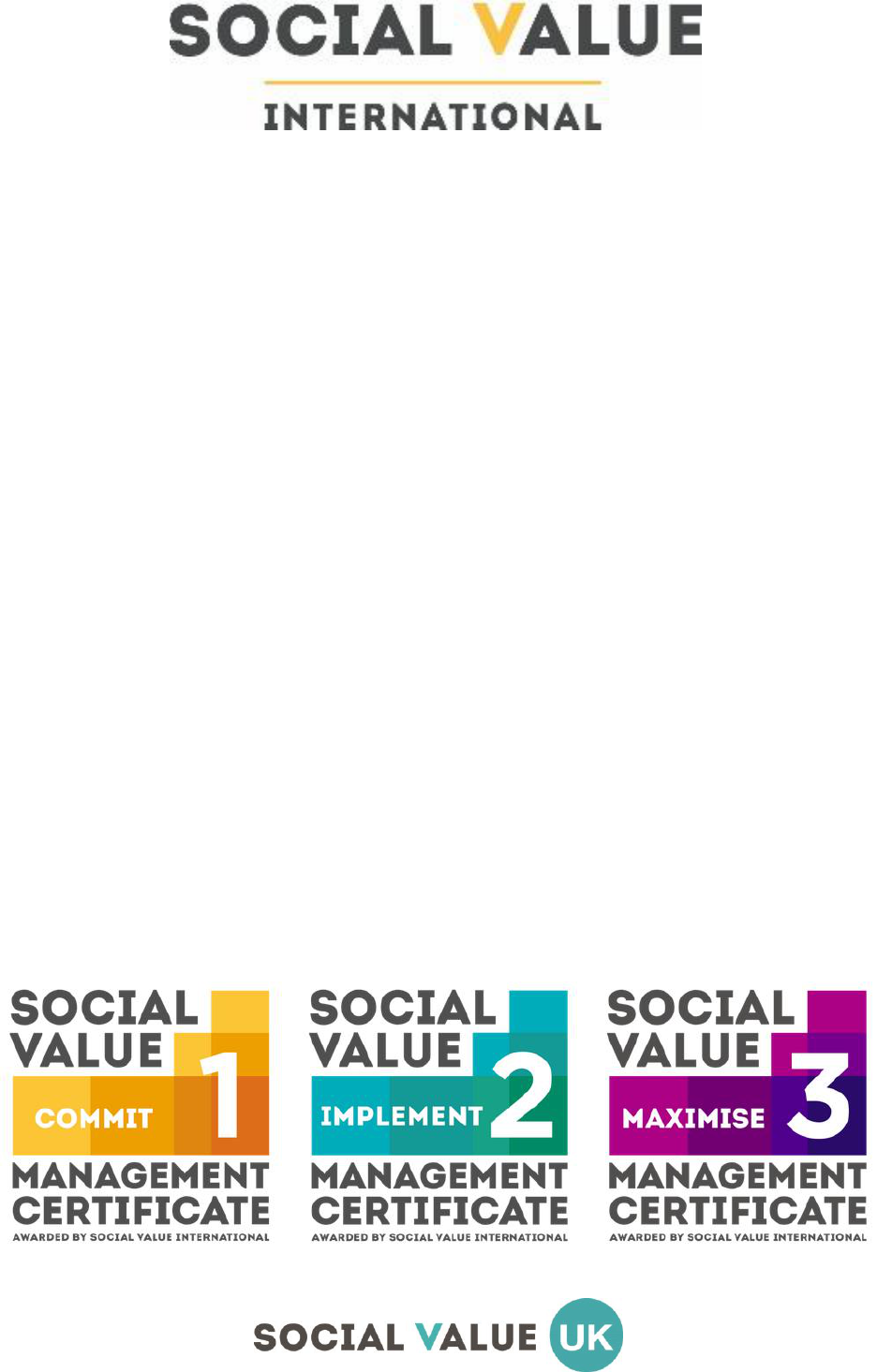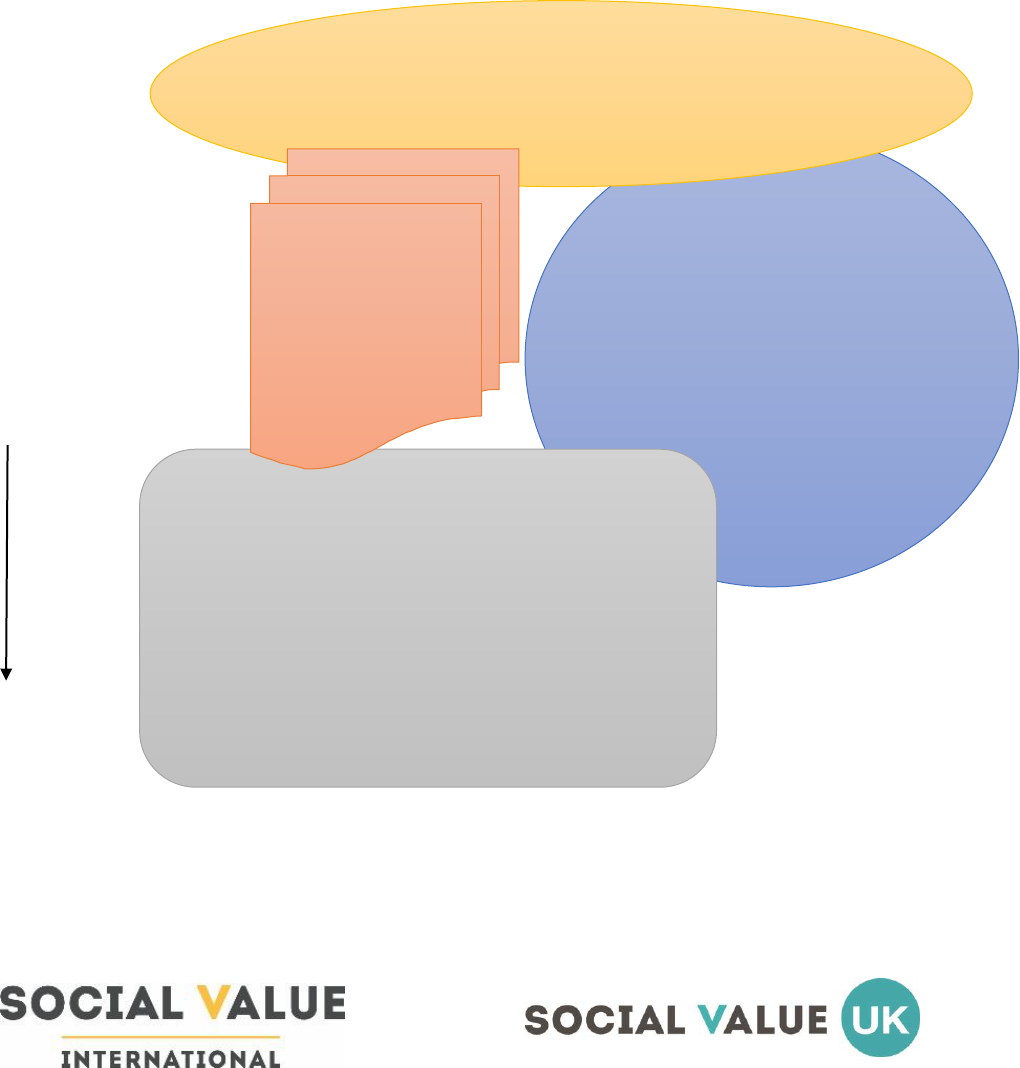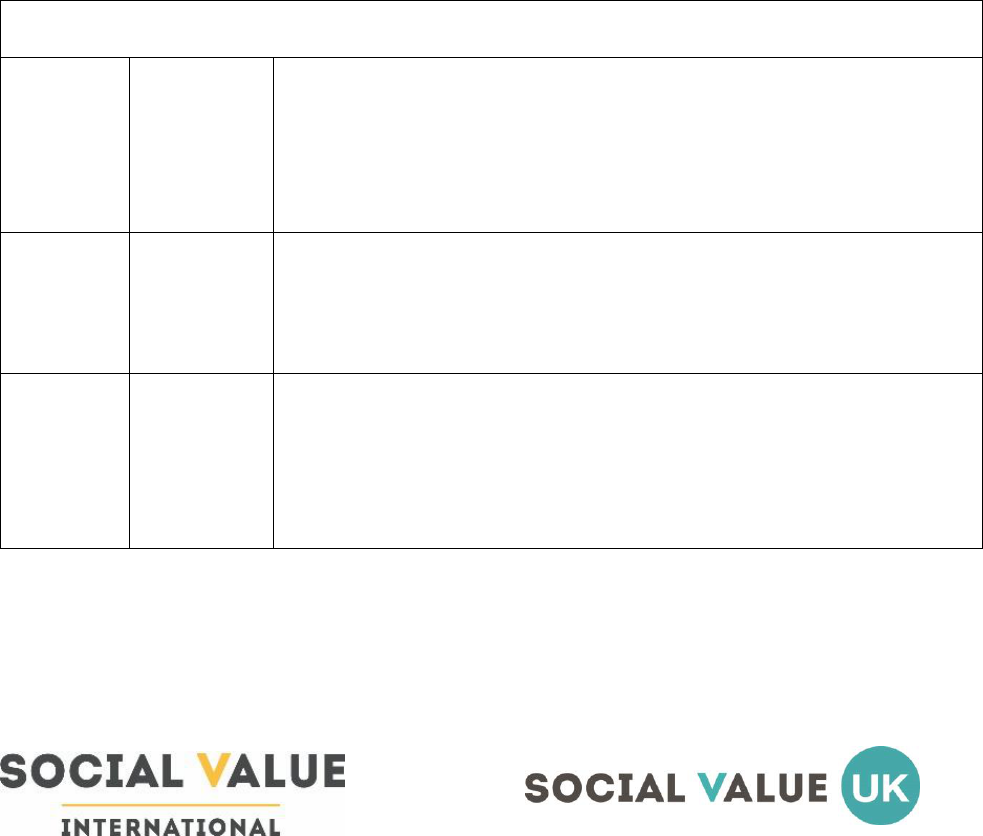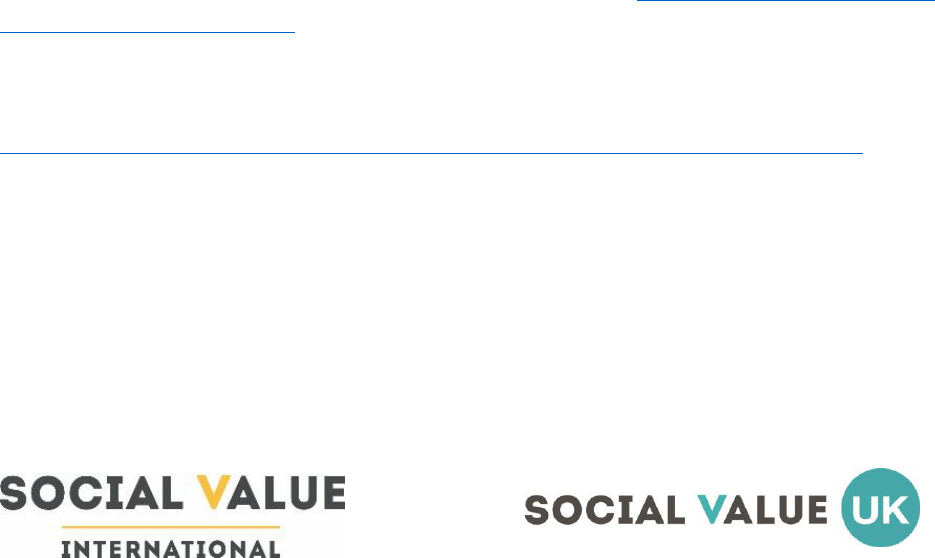
Social Value
Management
Certificate
Guidance Document

2
Contents
About the Social Value International Assurance and Accreditation Services ...... 3
About the Social Value Management Certificate Development ............................ 3
What is Social Value? .................................................................................................. 4
Who experiences Social Value in your activities? .................................................... 5
Section 2: The Social Value Management Certificate ................................................ 6
What is the Social Value Management Certificate? ................................................. 6
Why should I get the Social Value Management Certificate? ................................. 7
Organisational Social Value Representatives: ......................................................... 7
How to Apply ............................................................................................................... 7
Criteria for each level ................................................................................................. 8
What kind of Evidence can be used? ........................................................................ 9
Cost of Social Value Management Certificate application: .................................. 10
Frequently Asked Questions: .................................................................................. 11
Section 3: Support ...................................................................................................... 12
Ongoing Support ...................................................................................................... 12
1. Membership support........................................................................................ 12
2. Internal expertise .............................................................................................. 12
3. External expertise ............................................................................................. 13
Appendices .................................................................................................................. 14
Appendix 1: The Principles of Social Value ............................................................ 14
Appendix 2: The Social Value Self-Assessment Tool ............................................. 15
Appendix 3: 10 Impact Questions ........................................................................... 16
Appendix 4: Standards and Guidance .................................................................... 17

3
About the Social Value International Assurance and Accreditation
Services
The Social Value Management Certificate is part of Social Value International’s Assurance and
Accreditation services. These services are provided by Social Value UK on behalf of Social Value
International.
Contact Social Value UK at info@socialvalueuk.org if you have any questions or would like to discuss
an application with our team.
About the Social Value Management Certificate Development
The Social Value Management Certificate has been developed by Social Value UK and Social Value
International as part of the assurance and accreditation services. The SVI Framework and Social
Value Principles form the basis for the certification, as well as the Maximise your Impact Guide and
Impact Questions developed by SVUK.
The criteria for the Social Value Management Certificate are updated incrementally based on
methodological updates, feedback from users and awardees, and wider review and learning.
The current version of the Social Value Management Certificate is Version 2, published in March
2020.
The development of the criteria and certificates is overseen by Social Value International’s Reporting
and Assurance Technical Committee. There is more information on the SVI Governance on the
website: https://socialvalueint.org/social-value/governance/
For more information about the governance contact Social Value International at
hello@socialvalueint.org.

4
Section 1: Social Value
What is Social Value?
We all experience changes in our lives because of the activities that we undertake, the services we
use, and the people we interact with day to day. All of this has an impact on our overall wellbeing
and changes the way we experience life. Social value quantifies the amount of change we
experience and the relative importance we place on these different aspects of our lives. All of these
changes contribute to our overall wellbeing. The value can be both positive and negative. It can be
an intended outcome of an activity, or it can be an unexpected change that neither we, or the
organisers of the activity expected to happen. Changes can happen for those around us too, for our
families and friends.
There are some broad definitions of social value that incorporate social, environmental, and
economic value. In UK legislation this is expressed in reference to a place. For SVI and this certificate
we will be focusing on the social value created for people. Note: economic and environmental
outcomes are aspects of individual wellbeing and so these outcomes will be captured as they
become relevant for people (your stakeholders).
This certificate is designed to assess an organisations ability to capture and manage information
about the social value created through their activities. This needs to include value that is not
captured in market value.
To create as much social value as we can, we must manage the social value created through our
activities. There are many things we do each day that could have an effect on those around us, at
work (through our employment practices and work culture), through community engagement
(through volunteer activities, or community partnerships), or for our customers, client or end users
(through delivering the best service possible, with people’s experience at the centre of design).
To make sure we are managing and maximising the value we create we must collect data on how
our activities affect people’s lives. This may include checking against our intended goals but will also
include checking for unexpected changes in people’s lives. This could be both positive or negative.
Perhaps we have created a local park, but are we checking the experience the workers are having
whilst building it, and the local community experience during the building process, and afterwards
whilst they are using it? Are we planning to adjust our design and delivery of the park based on their
feedback of their experience and what has changed for them?
Social value management can help us to change the way we understand the world around us, and to
make better decisions about how to invest our resources and improve all of our lives.

5
Who experiences Social Value in your activities?
If we accept that social value is the changes that happen in people’s lives (aspects of their wellbeing) that they
consider to be most important, and that these changes can occur through a person’s interaction with different
activities, then we should accept that we will be affecting different groups of people in a variety of different
ways through any one activity that we are running.
The diagram below identifies some broad stakeholder groups that are likely to be affected by your activities.
This is a helpful starting point for beginning to map out your stakeholders. There may well be others, and there
will definitely be sub-groups within these broad groups. For example, other groups could include partner
organisations, public services, or the environment. There may also be blending between the groups. For
example, for a community organisation the local community are likely to also be the main end user group.
This is not an exhaustive list, but we recommend that this is used as a starting point for mapping out your
stakeholder groups. It can also help in recognising the different opportunities for creating value.
VALUE FOR COMMUNITY
Changing the lives of the
people in the local
community through:
Volunteering
Bespoke Projects
Charity donations etc
VALUE FOR WORKFORCE
Changing the lives of the people who work in
the organisation or project through:
Employment
Apprenticeships
Training
Volunteering (wellbeing from)
Supply
chain
VALUE FOR END USERS
Changing the lives of the people who are directly
using the service or activity
Your activity
(e.g. building a
hospital, running a
homeless shelter,
delivering training
courses, etc)

6
Section 2: The Social Value Management Certificate
What is the Social Value Management Certificate?
The Social Value Management Certificate is looking at the standard of an organisations practice in
managing the social value that is created (and destroyed) through its activities. This is not only about
reporting social value, it is about gathering data, analysing it, and making better informed decisions
to improve your stakeholders lives through creating the most social value that you can with your
resources. It does not provide proof or a statement that your organisation or programme is
creating a particular amount of social value, more that you are putting practice in place to
continuously improve the amount of value you are creating.
The Social Value Management Certificate is an organisational pathway and there should be an
explicit expectation when undertaking this journey that decision making, and organisational
activities will change throughout.
The Social Value Management Certificate can be awarded to an organisation or a specific
programme or project being run by an organisation. The Social Value Management Certificate has
three levels:
The Three Levels of the Social Value Certificate
Level 1
Commit
An organisation or programme must demonstrate a commitment to
embedding the SVI Framework and Social Value Principles into its policies
and practices, supported by senior management and/ or the board. This
means an explicit commitment to managing the social value being created
in the organisation for all stakeholders.
Level 2
Implement
The organisation or programme must show that the commitment to
managing social value in alignment to the SVI Framework and embedding
the Social Value Principles is being implemented into the organisational
practice. This will include evidence of data that has been collected.
Level 3
Manage
The organisation or programme must demonstrate that social value is being
managed with an aim to maximise the value that is being created within the
organisation’s available resources for all stakeholders. This means social
value data is being used in organisational decision making continuously and
systems and processes are being reviewed and improved.

7
Why should I get the Social Value Management Certificate?
The Social Value Management Certificate can help you to:
• Gain a competitive advantage: You can prove to external stakeholders (including funders/
investors/ commissioners) that you are aligning to an international standard for managing
social value and taking steps towards maximising the value that you can create.
• Improve your practice: You can follow a clear pathway for improving the way you are
measuring and managing your social value with the support of peers and an international
network of practitioners.
• Maximise: You can maximise the value you are creating for all of your stakeholders by
implementing robust systems to measure, manage and maximise your social value.
• Social risk management: The certificate can provide confidence to you, and your
stakeholders that you are taking steps to manage your social value.
Organisational Social Value Representatives:
An organisation will need to identify at least one lead person to progress implementation of the
Social Value Management Certificate. Senior level support is also imperative throughout the
certificate pathway and must be evidenced at all levels. These representatives should cover:
1) Social Value Lead: Identify a social value lead or champion who will be responsible for
implementing the Social Value Management Certificate.
2) Social Value Senior Leader: Identify a senior leader to provide oversight and ensure social value
is part of an organisations’ strategic priorities. Ideally this person will be part of the governance of
the organisation.
All evidence for each level of the certificate must be agreed and signed off by both identified Social
Value Representatives.
How to Apply
Carefully read this Guidance Document. It contains all the information you need.
The steps for application are:
1. Your organisation must have membership with Social Value International.
2. Organise a preparation call with the Assurance Manager before undertaking the application.
3. Read the Terms & Conditions of Application. A signed copy of these must be submitted with
your application.

8
4. Download and complete the relevant Criteria and Evidence Form for the relevant level from
our website.
5. Fill out the online application form and upload your supporting evidence.
Copies of the necessary supporting documents are available on our website here.
Before you apply it is also a good idea to use our Social Value Self-Assessment Tool. The tool gives
you a good introduction to all of the Social Value Principles. The tool helps you to diagnose where
your systems and processes are already meeting the standards. It also has a very useful set of tips
and guidance to help you improve the systems and processes you have in place. More information is
available on the Self-Assessment Tool in Appendix 2 of this guide.
Criteria for each level
The criteria for each level are based on the SVI Framework. This incorporates the Social Value
Principles, impact questions, and guidance and standards. These are all referenced in the
appendices of this document. We recommend you read these.
The certificate is applying the SVI Framework within an activity delivery cycle guided by the stages as
outlined in the Maximise your Impact guide: https://socialvalueint.org/wp-
content/uploads/2018/05/MaximiseYourImpact.24.10.17.pdf.
The list of criteria for each level is detailed on the Social Value Management Certificate Criteria
document. The criteria for each level are also included on the criteria and evidence form that needs
to be completed and submitted with your application.
The criteria are structured into 5 stages as below:
1. Creating Capacity - this pre-stage is asking for your organisation to build internal capacity so
that you have the capability to manage your social value over time.
2. Plan – in this stage you will create (or review) your strategy and business plan which will
include an impact management plan and an operations plan. Carry out user research,
testing and co-design of products and services.
3. Do – in this stage you will design surveys and collect quantitative data from stakeholders
about the changes they experience, and store and organise the data ready for analysis.
4. Assess – in this stage, you will analyse the data you have collected.
5. Revise - with your data and analysis in place, in this stage you will focus on using this as the
basis for making decisions that are focused on maximising your impact. In most cases your
decisions will come down to choosing between three courses of action: change, stop or
scale-up.

9
What kind of Evidence can be used?
An organisation will need to provide evidence to meet all of the criteria for each level of the
certificate. The evidence will need to be in a format that is actionable within an organisation. Types
of evidence could include:
Level 1: Commitment to all criteria:
• Planning and structural documentation, e.g.:
– A policy
– A strategy
– An action plan / project plan / work plan for implementing SV practice
***Not looking for evidence of implementation***
Level 2: Implementation of your commitment:
• An action plan / project plan / work plan for implementing SV practice (i.e. the one that was
developed for Level 1, if done so).
• Evidence of action starting to happen, e.g.:
– A stakeholder map
– Interview / focus group data
– A data management system (could be a spreadsheet)
– Senior level engagement (minutes from board meetings)
– Considerations of materiality and causality
– Evidence of some changes and decisions made
Level 3: Manage - Decision making taking place
• An action plan / project plan / work plan for implementing SV practice (i.e. the one that was
developed for Level 1, and used for Level 2).
• Embedding in more parts of the organization (i.e. evidence for more than one area)
• Continuous processes (i.e. more than one time)
• Learning / changes made to activities, and to social value management systems and
processes
For Level 1 of the certificate there are some templates available that may help. These are for Social
Value Policies and action plans and they are available on the Social Value International website.

10
Cost of Social Value Management Certificate application:
To make an application for the Social Value Management Certificate you must be an organisational
member of Social Value International (or an affiliated National Network).
Membership type
Level 1
Level 2
Level 3
Renewal (of
level 3)
Organisational member (small)
£500.00
£500.00
£500.00
£500.00
Organisational member (medium)
£750.00
£750.00
£750.00
£750.00
Organisational member (large)
£1000.00
£1000.00
£1000.00
£1000.00
Organisational member (very large)
£1250.00
£1250.00
£1250.00
£1250.00
All prices are in GBP and are exclusive of VAT.
PLEASE NOTE:
• The price increases incrementally due to the increased complexity of organisational
structure in larger organisations.
• The certificate is a process so each level must be achieved to be able to move to the next
level.
• The Social Value Management Certificate is directly linked to organisational membership,
your organisation must be a member of Social Value International to be on the certificate
pathway.
• There may be some discounts available through your membership, which will be detailed in
your membership information. Talk to the SVUK Engagement Team to find out more

11
Frequently Asked Questions:
When can I apply for the Social Value Management Certificate?
Whilst you can start preparing for your application at any time, and submit this through the Social
Value International website, your application will only be processed during the Social Value
Management Certificate rounds. There are 4 rounds throughout the year running for 2 weeks. The
dates of these can be found on the Social Value International Assurance page on the website.
How long does the process take?
There are a number of steps to take to get to the award stage of the certificate which includes an
initial conversation, discussion on evidence, gathering of evidence and producing documents, and
the review and feedback stages. This means that the process is very dependent on where you as an
organisation are in terms of managing your own social value. It can also be dependent on the size
and complexity of your operations.
How long will my results take from the date of application?
The initial results will be available approximately 3 weeks after a complete application is received.
There may be feedback and amendments that need to be made so plan for the process to take at
least 1 month for amendments to be implemented after initial feedback has been received.
Can you apply for more than one level at one time?
No. You must have each level in place before applying for the next level.
What membership is acceptable for applying for the Social Value Certificate?
You must be an organisational member of Social Value International to apply for the certificate. This
can be through one of the Joint Member Networks of Social Value International.
Can individual members of Social Value International apply for the certificate?
You cannot apply for the certificate as an individual member.
How long does accreditation last?
Accreditation is valid for two years.

12
Section 3: Support
Ongoing Support
The Social Value Management Certificate is an organisational journey. It is likely to take an
organisation a number of years to work through all 3 levels. There is an explicit expectation that an
organisation will progress from each level to the next, and renewal of the certificate will require
evidence of systems still be used and developed.
This type of organisational change is likely to require work, resources, time, and engagement across
the organisation. It will also require support. We have recognised 3 types of support that can help an
organisation in this journey:
1. Membership support
There is a variety of support that is offered through the SVI (and National Networks) organisational
membership that can assist in an organisations journey. This could include:
• An SVI / National Network lead strategic workshop
• Access to a library of past webinars
• Case studies
• Support from the SVI team
• Training to develop a team members internal expertise. This could lead to Accredited
Practitioner qualification
• Engagement in a network event
2. Internal expertise
Some organisations are lucky to have internal expertise to support the development of internal
processes, systems, and practices. This internal advocacy, knowledge and skill can support an
organisation from the inside to develop and embed their own best practice.
This person may be an SVI Practitioner with an accredited knowledge of the SVI Framework and
Social Value Principles.

13
3. External expertise
Some organisations will not have this internal skill pre-developed and so can either look to develop
this internally as a part of the process or can seek external support.
There are a couple of avenues that SVI can assist with in seeking external support:
• SVI have a community of Practitioners of 3 levels many of whom work supporting
organisations to develop and embed best social value management practice. A register of
SVI Practitioners is available here.
• There is also a directory of consultants on the Social Value UK website with support
organisations who can assist with embedding best practice and in achieving the next level of
your Social Value Certificate. Find a consultant on the Social Value UK website.

14
Appendices
Appendix 1: The Principles of Social Value
1. Involve stakeholders — Inform what gets measured and how this is measured and valued in
an account of social value by involving stakeholders.
2. Understand what changes — Articulate how change is created and evaluate this through
evidence gathered, recognising positive and negative changes as well as those that are
intended and unintended.
3. Value the things that matter — Making decisions about allocating resources between
different options needs to recognise the values of stakeholders. Value refers to the relative
importance of different outcomes. It is informed by stakeholders’ preferences.
4. Only include what is material — Determine what information and evidence must be included
in the accounts to give a true and fair picture, such that stakeholders can draw reasonable
conclusions about impact.
5. Do not over-claim — Only claim the value that activities are responsible for creating.
6. Be transparent — Demonstrate the basis on which the analysis may be considered accurate
and honest, and show that it will be reported to and discussed with stakeholders.
7. Verify the result — Ensure appropriate independent audit.
You can read more about the Social Value Principles on the website: https://socialvalueint.org/social-
value/principles-of-social-value/.
For more details see the Principles of Social Value introductory guide:
https://socialvalueint.org/social-value/standards-and-guidance/the-principles-of-social-value/.

15
Appendix 2: The Social Value Self-Assessment Tool
The Social Value Self-Assessment Tool is designed to help users judge how well they are measuring
and reporting on their social value, in line with the Principles of Social Value.
It was created in collaboration with our members Hall Aitken.
The tool is comprised of a seven-stage questionnaire, showing results as a spider chart illustrating
areas of strength and areas for improvement.
By using the Self-Assessment Tool you can:
• Fully explore the benefits of the Social Value Principles.
• Get advice on what to do next.
• Get an accurate baseline of how good your current social value measurement practices are.
• High scoring users can then use their score to guide them towards applying for assurance
and accreditation.
• Judge your readiness for Social Value Certificate application.
The tool provides guidance, support and more advice to people who want to improve the way in
which their organisation measures their social value and assesses their service delivery but don’t
know where to start. To access the tool, users can create an account and sign up for free here.

16
Appendix 3: 10 Impact Questions
The Ten Impact Questions outlined below and are fundamental to maximising impact. For more
information on how to apply the impact questions, read ‘Maximise Your Impact.’
1. What problem are we trying to solve?
2. What is our proposed solution to the problem?
3. Who experiences changes in their lives as a result of what you do?
4. What outcomes are (or likely to be) experienced?
5. How can we measure the amount of change to the outcomes?
6. How much change in each outcome has happened (or is likely to happen)?
7. How long do we need to measure the outcomes for?
8. What is the relative importance of the different changes in outcomes?
9. How much of the change in each outcome is caused by our activities?
10. Which changes matter and are important enough for us to manage?
There are also three overarching questions you will need to consider:
1. Who should answer them?
2. How rigorous do the answers need to be to inform your decisions?
3. What assurances do you need that the information is relevant, complete and accurate
before you are able to make those decisions?

17
Appendix 4: Standards and Guidance
The guidance and standards guide all of the work of Social Value International. They shape the
criteria that is used in assessment for all of the assurance and accreditation services including the
Social Value Certificate
All of Social Value International’s standards and guidance documents are developed collaboratively
with our members across the globe. Developments are led by our board and subcommittees. To
find out more about the committees click here.
All of the standards and guidance can be found here: https://socialvalueint.org/social-
value/standards-and-guidance/
Standards:
1. Standard on applying Principle 1: Involve Stakeholders: https://socialvalueint.org/social-
value/standards-and-guidance/standard-on-applying-principle-1-involve-stakeholders-2/
2. Standard on applying Principle 2: Understand What Changes (Part 1):
https://socialvalueint.org/social-value/standards-and-guidance/standard-on-applying-
principle-2-understand-what-changes-part-1/
3. Standard on applying Principle 3: Value the things that matter:
http://www.socialvalueuk.org/app/uploads/2019/12/Standard-on-applying-Principle-3-Value-
the-Things-that-Matter-FINAL.pdf
4. Standard on applying Principle 4: Only Include What is Material:
https://socialvalueint.org/social-value/standards-and-guidance/standard-on-applying-
principle-4-only-include-what-is-material/

18
Social Value International
Suite 620c, Cotton Exchange Building, Bixteth Street, L3 9BB, Liverpool
www.socialvalueint.org I hello@socialvalueint.org I @socialvalueint
Registered charity number 1142874.
A company limited by guarantee. Registered in England and Wales No 7568122.
Version Published March 2021/
